Renewable Energy Role in Climate Stabilization and Water Consumption Minimization in Jordan
Abstract
1. Introduction
1.1. Climate Change Occurrence Due to CO2 Release
1.2. Fossil Fuel Contribution to Climate Change
- This study investigates the amount of the mitigated amount of CO2 due to producing electricity from wind and solar PV projects in Jordan, accordingly estimating the mitigated rising in temperature.
- The water consumption reduction due to cooling—the free phase in wind and solar PV projects is also discussed.
- Providing a section that clarifies the future situation based on covering the demand for renewable energy projects.
2. Role of Renewable Energy in CO2 Reduction
3. Water Consumption Reduction Due to Fossil Fuel Replacement
4. Methodology
5. Results and Discussion
5.1. Temperature Rising Avoidance Estimation
5.2. Water Consumption Outcomes
6. Future Situation Estimation
7. Conclusions
Author Contributions
Funding
Data Availability Statement
Acknowledgments
Conflicts of Interest
Symbols and Abbreviations
| GHG | Greenhouse gases | tCO2 | Tons of carbon dioxide. |
| IPCC | Intergovernmental Panel on Climate Change | Mt | Megaton |
| WG3 | Working Group III | MWh | Megawatt hour |
| RETs | Renewable Energy Technologies | GWh | Gigawatt hour |
| GDP | Gross Domestic Product | ρ | Air Density |
| tCO2 | Tons of carbon dioxide. | V | Wind Velocity |
References
- Manabe, S. Role of greenhouse gas in climate change. Tellus A Dyn. Meteorol. Oceanogr. 2019, 71, 1620078. [Google Scholar] [CrossRef]
- Shobande, O.A. Is climate change a monetary phenomenon? Evidence from time series analysis. Int. J. Sustain. Dev. World Ecol. 2021, 29, 99–111. [Google Scholar] [CrossRef]
- Atwoli, L.; Muhia, J.; Merali, Z. Mental health and climate change in Africa. BJPsych Int. 2022, 19, 86–89. [Google Scholar] [CrossRef]
- IPCC. Climate Change 2022: Impacts, Adaptation and Vulnerability. 2022. Available online: https://www.ipcc.ch/report/ar6/wg2/ (accessed on 3 August 2023).
- Ledley, T.S.; Sundquist, E.T.; Schwartz, S.E.; Hall, D.K.; Fellows, J.D.; Killeen, T.L. Climate change and greenhouse gases. Eos Trans. Am. Geophys. Union 1999, 80, 453–458. [Google Scholar] [CrossRef]
- United States Environmental Protection Agency. Overview of Greenhouse Gases. 16 May 2022. Available online: https://www.epa.gov/ghgemissions/overview-greenhouse-gases (accessed on 3 August 2023).
- Jeffry, L.; Ong, M.Y.; Nomanbhay, S.; Mofijur, M.; Mubashir, M.; Show, P.L. Greenhouse gases utilization: A review. Fuel 2021, 301, 121017. [Google Scholar] [CrossRef]
- Soeder, D.J. Fracking and the Environment: A Scientific Assessment of the Environmental Risks from Hydraulic Fracturing and Fossil Fuels; Springer: Cham, Switzerland, 2021. [Google Scholar]
- Lamb, W.F.; Wiedmann, T.; Pongratz, J.; Andrew, R.; Crippa, M.; Olivier, J.G.J.; Wiedenhofer, D.; Mattioli, G.; Al Khourdajie, A.; House, J.; et al. A review of trends and drivers of greenhouse gas emissions by sector from 1990 to 2018. Environ. Res. Lett. 2021, 16, 073005. [Google Scholar] [CrossRef]
- Roberts, D. What’s Causing Climate Change, in 10 Charts. Vox. 11 September 2020. Available online: https://www.vox.com/energy-and-environment/21428525/climate-change-cause-charts-china-us-responsible (accessed on 3 August 2023).
- National Electric Power Company (NEPCO). Annual Report; NEPCO: Amman, Jordan, 2021. [Google Scholar]
- Crippa, M.; Guizzardi, D.; Banja, M.; Solazzo, E.; Muntean, M.; Schaaf, E.; Pagani, F.; Monforti-Ferrario, F.; Olivier, J.G.J.; Quad-relli, R.; et al. CO2 Emissions of All World Countries—JRC/IEA/PBL 2022 Report; Publications Office of the European Union: Luxembourg, 2022; JRC130363. [Google Scholar] [CrossRef]
- Perera, F.; Nadeau, K. Climate Change, Fossil-Fuel Pollution, and Children’s Health. N. Engl. J. Med. 2022, 386, 2303–2314. [Google Scholar] [CrossRef] [PubMed]
- Le Quéré, C.; Korsbakken, J.I.; Wilson, C.; Tosun, J.; Andrew, R.; Andres, R.J.; Canadell, J.G.; Jordan, A.; Peters, G.P.; van Vuuren, D.P. Drivers of declining CO2 emissions in 18 developed economies. Nat. Clim. Chang. 2019, 9, 213–217. [Google Scholar] [CrossRef]
- IIs Climate Change the World’s Biggest Problem? And What Can We Do about It? Available online: https://www.givingwhatwecan.org/cause-areas/long-term-future/climate-change?gclid=CjwKCAiAk--dBhABEiwAchIwkVhtZtkGhNFAmQtXD-2c-si8ECC3fCjkDa9dLOqKYQNkhH866yWNrhoCrCUQAvD_BwE (accessed on 20 January 2023).
- Al-Hasani, I.; Al-Qinna, M.; Hammouri, N.A. Potential Impacts of Climate Change on Surface Water Resources in Arid Regions Using Downscaled Regional Circulation Model and Soil Water Assessment Tool, a Case Study of Amman-Zerqa Basin, Jordan. Climate 2023, 11, 51. [Google Scholar] [CrossRef]
- Cal-Adapt. Available online: https://cal-adapt.org/help/faqs/which-rcp-scenarios-should-i-use-in-my-analysis/ (accessed on 3 August 2023).
- Rovinaru, M.D.; Bako, D.E.; Rovinaru, F.I.; Rus, A.V.; Aldea, S.G. Where Are We Heading? Tackling the Climate Change in a Globalized World. Sustainability 2022, 15, 565. [Google Scholar] [CrossRef]
- Tavakoli, A. How precisely “kaya identity” can estimate GHG emissions: A global review. Jordan J. Earth Environ. Sci. 2017, 8, 91–96. [Google Scholar]
- Hwang, Y.; Um, J.-S.; Hwang, J.; Schlüter, S. Evaluating the Causal Relations between the Kaya Identity Index and ODIAC-Based Fossil Fuel CO2 Flux. Energies 2020, 13, 6009. [Google Scholar] [CrossRef]
- Guyadeen, D.; Henstra, D. Evaluating rural municipal climate change plans in ontario, Canada. J. Rural. Stud. 2023, 97, 123–139. [Google Scholar] [CrossRef]
- Zhang, C.-Y.; Oki, T. Water pricing reform for sustainable water resources management in China’s agricultural sector. Agric. Water Manag. 2023, 275, 108045. [Google Scholar] [CrossRef]
- Sahana, V.; Mondal, A. Evolution of multivariate drought hazard, vulnerability and risk in India under climate change. Nat. Hazards Earth Syst. Sci. 2023, 23, 623–641. [Google Scholar] [CrossRef]
- Hruby, F. Applications of Bivariate Choropleth Maps. In Proceedings of the 15th International Multidisciplinary Scientific Geoconference SGEM 2015, Albena, Bulgaria, 18–24 June 2015. [Google Scholar] [CrossRef]
- Smith, J.C.; Whiley, H.; Ross, K.E. Climate Change and Health: Local Government Capacity for Health Protection in Australia. Int. J. Environ. Res. Public Health 2023, 20, 1750. [Google Scholar] [CrossRef]
- Nayak, M.S.D.P.; Narayan, K.A. Strengths and weaknesses of online surveys. Technology 2019, 6, 0837–2405053138. [Google Scholar]
- Azouz, M.; Salem, D. Urban resilience and stormwater management: Lessons learnt from New Cairo, Egypt. Ain Shams Eng. J. 2023, 14, 102117. [Google Scholar] [CrossRef]
- François, D.; Youssef, Z. Where to measure water quality? Application to nitrogen pollution in a catchment in France. J. Environ. Manag. 2023, 326, 116721. [Google Scholar] [CrossRef]
- Sugimura, Y.; Kawasaki, T.; Murakami, S. Potential for Increased Use of Secondary Raw Materials in the Copper Industry as a Countermeasure Against Climate Change in Japan. Sustain. Prod. Consum. 2023, 35, 275–286. [Google Scholar] [CrossRef]
- Jungudo, M. The Impact of Climate Change in Egypt. In Resource Conflict and Environmental Relations in Africa; Springer Nature: Singapore, 2023; pp. 173–188. [Google Scholar]
- Al-Omari, A.; Al-Houri, Z.; Muhammetoglu, H.; Muhammetoglu, A.; Topkaya, B. Energy and Carbon Footprints for the Urban Water Cycle in Amman, Jordan. Int. J. Environ. Res. 2022, 16, 87. [Google Scholar] [CrossRef]
- Sandri, S.; Hussein, H.; Alshyab, N. Sustainability of the Energy Sector in Jordan: Challenges and Opportunities. Sustainability 2020, 12, 10465. [Google Scholar] [CrossRef]
- Talozi, S.A. Water and security in Jordan. In Integrated Water Resources Management and Security in the Middle East; Springer: Dordrecht, The Netherlands, 2007; pp. 73–98. [Google Scholar]
- Salameh, E. Water Security Needs What Ought to Be Done to Increase the Future Water Security as a Fundamental Base for Social, Economic and Political Stability—The Case of Jordan. J. Geosci. Environ. Prot. 2022, 10, 1–17. [Google Scholar] [CrossRef]
- Al Naber, M.; Molle, F. Controlling groundwater over abstraction: State policies vs local practices in the Jordan highlands. Water Policy 2017, 19, 692–708. [Google Scholar] [CrossRef]
- Hussein, H. Yarmouk, Jordan, and Disi basins: Examining the impact of the discourse of water scarcity in Jordan on transboundary water governance. Mediterr. Politics 2019, 24, 269–289. [Google Scholar] [CrossRef]
- Ellabban, O.; Abu-Rub, H.; Blaabjerg, F. Renewable energy resources: Current status, future prospects and their enabling technology. Renew. Sustain. Energy Rev. 2014, 39, 748–764. [Google Scholar] [CrossRef]
- Owusu, P.A.; Asumadu-Sarkodie, S. A review of renewable energy sources, sustainability issues and climate change mitigation. Cogent Eng. 2016, 3, 1167990. [Google Scholar] [CrossRef]
- Javaid, A.; Arshed, N.; Munir, M.; Zakaria, Z.A.; Alamri, F.S.; Khalifa, H.A.E.-W.; Hanif, U. Econometric Assessment of Institutional Quality in Mitigating Global Climate-Change Risk. Sustainability 2022, 14, 669. [Google Scholar] [CrossRef]
- Suman, A. Role of renewable energy technologies in climate change adaptation and mitigation: A brief review from Nepal. Renew. Sustain. Energy Rev. 2021, 151, 111524. [Google Scholar] [CrossRef]
- Surendra, K.C.; Khanal, S.K.; Shrestha, P.; Lamsal, B. Current status of renewable energy in Nepal: Opportunities and challenges. Renew. Sustain. Energy Rev. 2011, 15, 4107–4117. [Google Scholar] [CrossRef]
- ArcGIS Web Application. Available online: https://memrgis.memr.gov.jo/portal/apps/webappviewer/index.html?id=718d18fa725f444094355abd6e729e18&fbclid=IwAR3EVm3QtXUAcBNvtl4cu8Wiu4TCDrbVSHlvL9PP-fu55mw54bKouT2OwRE (accessed on 15 March 2023).
- Solar Resource Maps of Jordan. Available online: https://solargis.com/maps-and-gis-data/download/jordan?fbclid=IwAR0_SVrEoHcp2a6KO-1qlVjwB-7M3TMH16VgcPqM12p-kHRgRj3vMrDDM_A (accessed on 15 March 2023).
- Global Wind Atlas. 2019. Available online: https://globalwindatlas.info/ (accessed on 3 August 2023).
- Darwish, H.H.; Al-Quraan, A. Machine Learning Classification and Prediction of Wind Estimation Using Artificial Intelligence Techniques and Normal PDF. Sustainability 2023, 15, 3270. [Google Scholar] [CrossRef]
- Al-Quraan, A.; Al-Mhairat, B. Intelligent Optimized Wind Turbine Cost Analysis for Different Wind Sites in Jordan. Sustainability 2022, 14, 3075. [Google Scholar] [CrossRef]
- Schuetze, B.; Hussein, H. The geopolitical economy of an undermined energy transition: The case of Jordan. Energy Policy 2023, 180, 113655. [Google Scholar] [CrossRef]
- World Nuclear Association. Comparison of Lifecycle Greenhouse Gas Emissions of Various Electricity Generation Sources; World Nuclear Association: London, UK, 2011. [Google Scholar]
- Minister of Energy and Mineral Resources (MEMR). Annual Report; NEPCO: Amman, Jordan, 2021.
- World Bank. World Bank Group—International Development, Poverty, & Sustainability. Available online: https://www.worldbank.org/en/home (accessed on 10 October 2021).
- South Amman Solar Conversion Plant Ready for Operation. Jordan Times. 3 November 2019. Available online: https://jordantimes.com/news/local/south-amman-solar-conversion-plant-ready-operation (accessed on 22 April 2023).
- Al-Mhairat, B.; Al-Quraan, A. Assessment of Wind Energy Resources in Jordan Using Different Optimization Techniques. Processes 2022, 10, 105. [Google Scholar] [CrossRef]
- Jin, Y.; Behrens, P.; Tukker, A.; Scherer, L. Water use of electricity technologies: A global meta-analysis. Renew. Sustain. Energy Rev. 2019, 115, 109391. [Google Scholar] [CrossRef]
- Akkam, Y.; Omari, D.; Alhmoud, H.; Alajmi, M.; Akkam, N.; Aljarrah, I. Assessment of Xenoestrogens in Jordanian Water System: Activity and Identification. Toxics 2023, 11, 63. [Google Scholar] [CrossRef]
- Introduction into Water in Jordan. Fanack Water. Available online: https://water.fanack.com/jordan/ (accessed on 3 August 2023).
- Adisorn, T.; Venjakob, M.; Pössinger, J.; Ersoy, S.R.; Wagner, O.; Moser, R. Implications of the Interrelations between the (Waste)Water Sector and Hydrogen Production for Arid Countries Using the Example of Jordan. Sustainability 2023, 15, 5447. [Google Scholar] [CrossRef]
- Nerc.gov.jo. 2020. Available online: http://www.nerc.gov.jo/EN/ListDetails/Energy_Efficiency_Projects/1035/17 (accessed on 3 August 2023).
- Lubega, W.N.; Stillwell, A.S. Analyzing the economic value of thermal power plant cooling water consumption. Water Resour. Econ. 2019, 27, 100137. [Google Scholar] [CrossRef]
- Pan, S.-Y.; Snyder, S.W.; Packman, A.I.; Lin, Y.J.; Chiang, P.-C. Cooling water use in thermoelectric power generation and its associated challenges for addressing water-energy nexus. Water-Energy Nexus 2018, 1, 26–41. [Google Scholar] [CrossRef]
- POWER. Water Conservation Options for Power Generation Facilities, POWER Magazine. 1 September 2012. Available online: https://www.powermag.com/water-conservation-options-for-power-generation-facilities/ (accessed on 3 August 2023).
- Clean Energy Project Analysis: RETScreen ® Engineering & Cases Textbook, Third Edition. Available online: https://nrcaniets.blob.core.windows.net/iets/M154-13-2005E.pdf (accessed on 19 July 2023).
- World Bank Climate Change Knowledge Portal. Available online: https://climateknowledgeportal.worldbank.org/country/jordan/climate-data-historical (accessed on 3 August 2023).
- Radaideh, A.; Bodoor, M.; Al-Quraan, A. Active and Reactive Power Control for Wind Turbines Based DFIG Using LQR Controller with Optimal Gain-Scheduling. J. Electr. Comput.Eng. 2021, 2021, 1218236. [Google Scholar] [CrossRef]
- Convert Gallon (US) to Cubic Meter. Available online: https://www.unitconverters.net/volume/gallon-us-to-cubic-meter.htm (accessed on 3 August 2023).
- World Population Review. Jordan Population 2020 (Demographics, Maps, Graphs). 2020. Available online: https://worldpopulationreview.com/countries/jordan-population (accessed on 3 August 2023).
- Abu-Rumman, G.; Khdair, A.I.; Khdair, S.I. Current status and future investment potential in renewable energy in Jordan: An overview. Heliyon 2020, 6, e03346. [Google Scholar] [CrossRef] [PubMed]
- Writer, S.; Times, T.J. Electricity Consumption Reaches New Heights in Jordan. Available online: https://www.zawya.com/en/economy/levant/electricity-consumption-reaches-new-heights-in-jordan-mtnmtt (accessed on 3 August 2023).
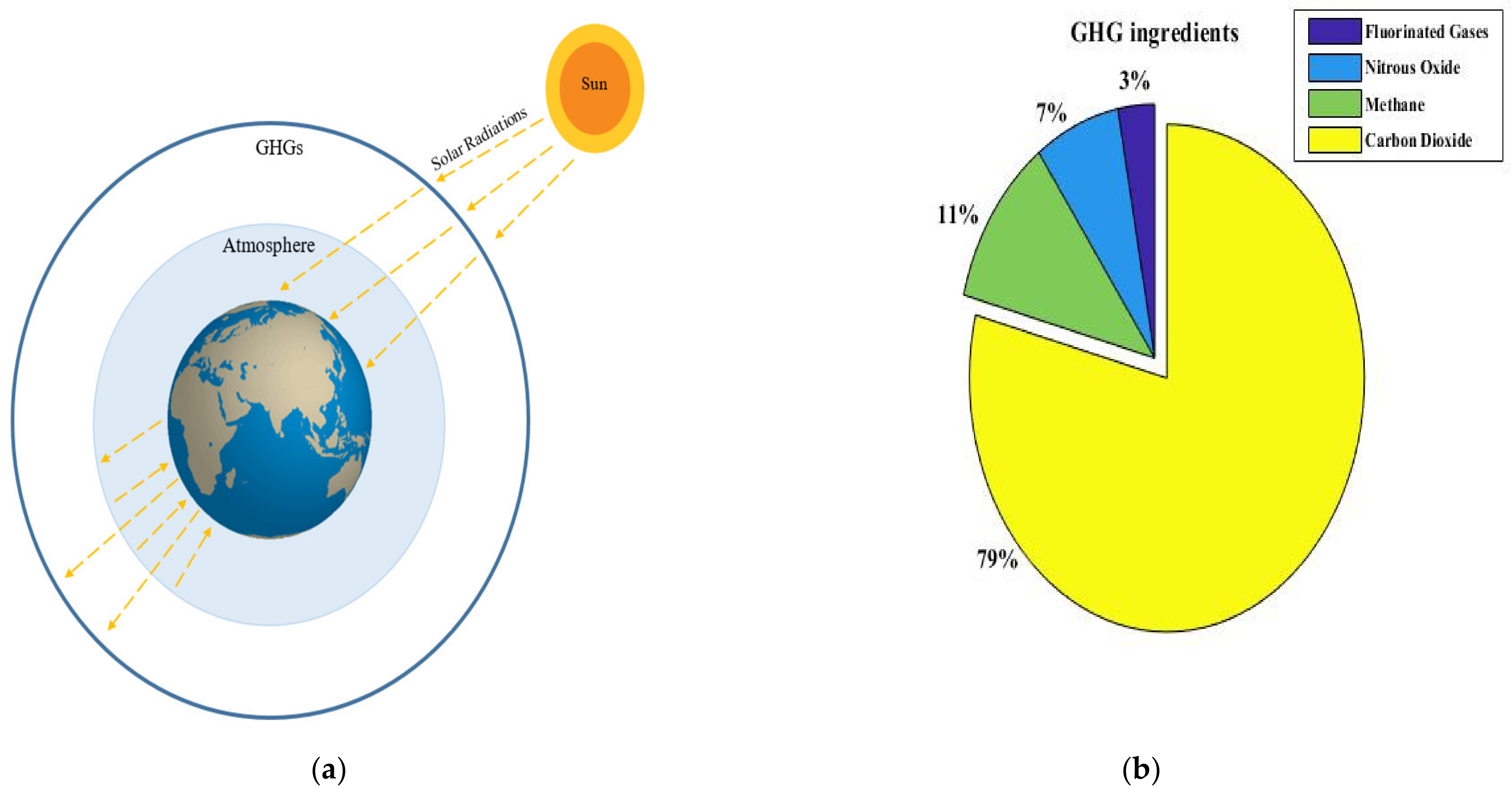


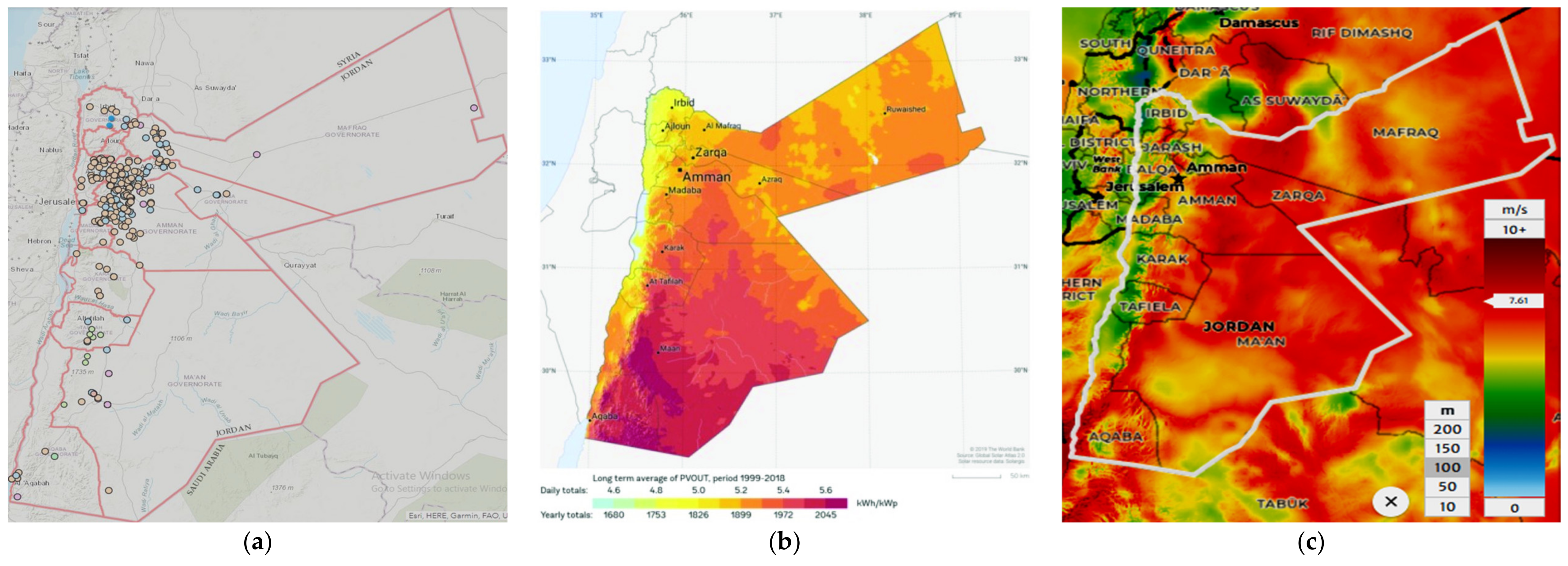
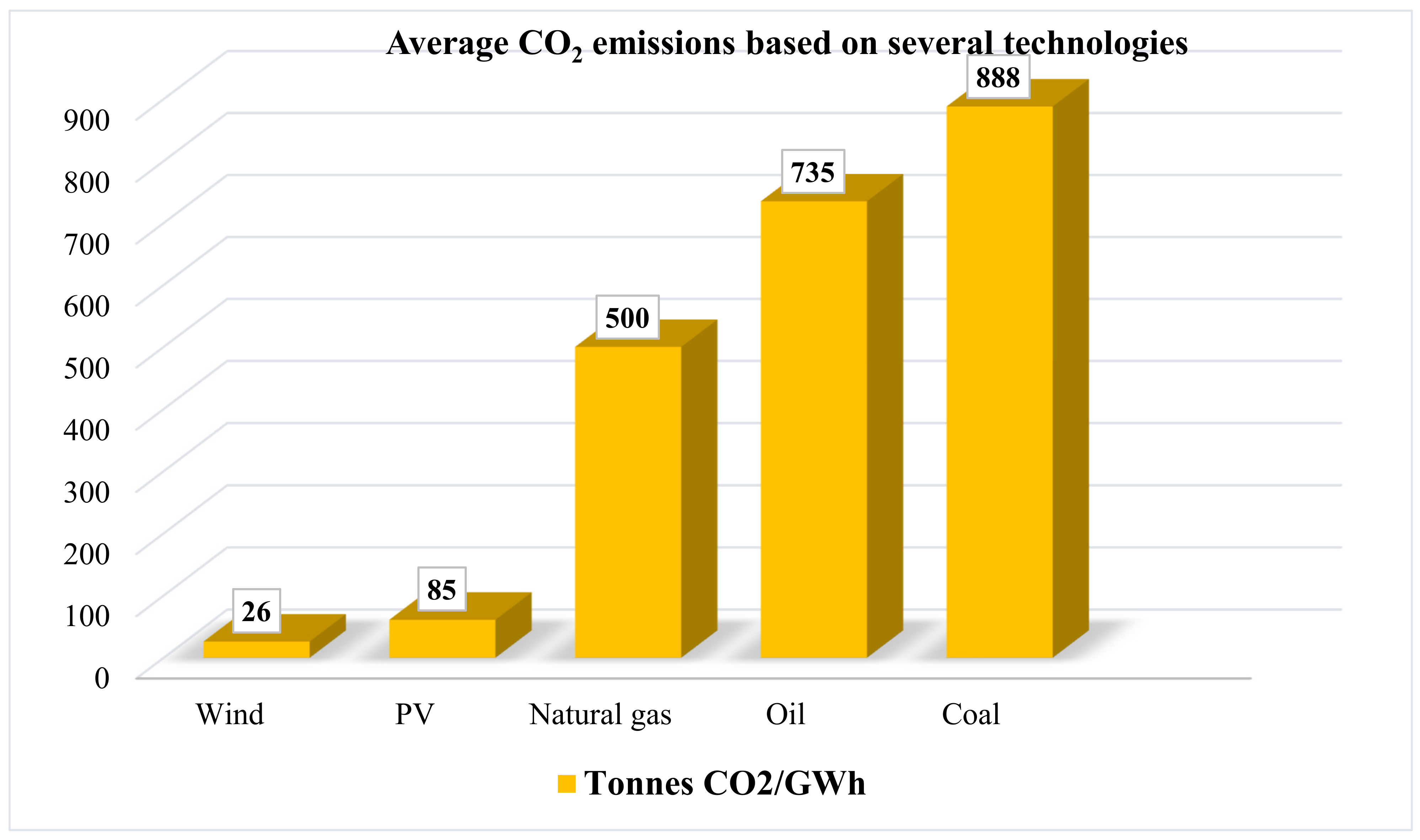
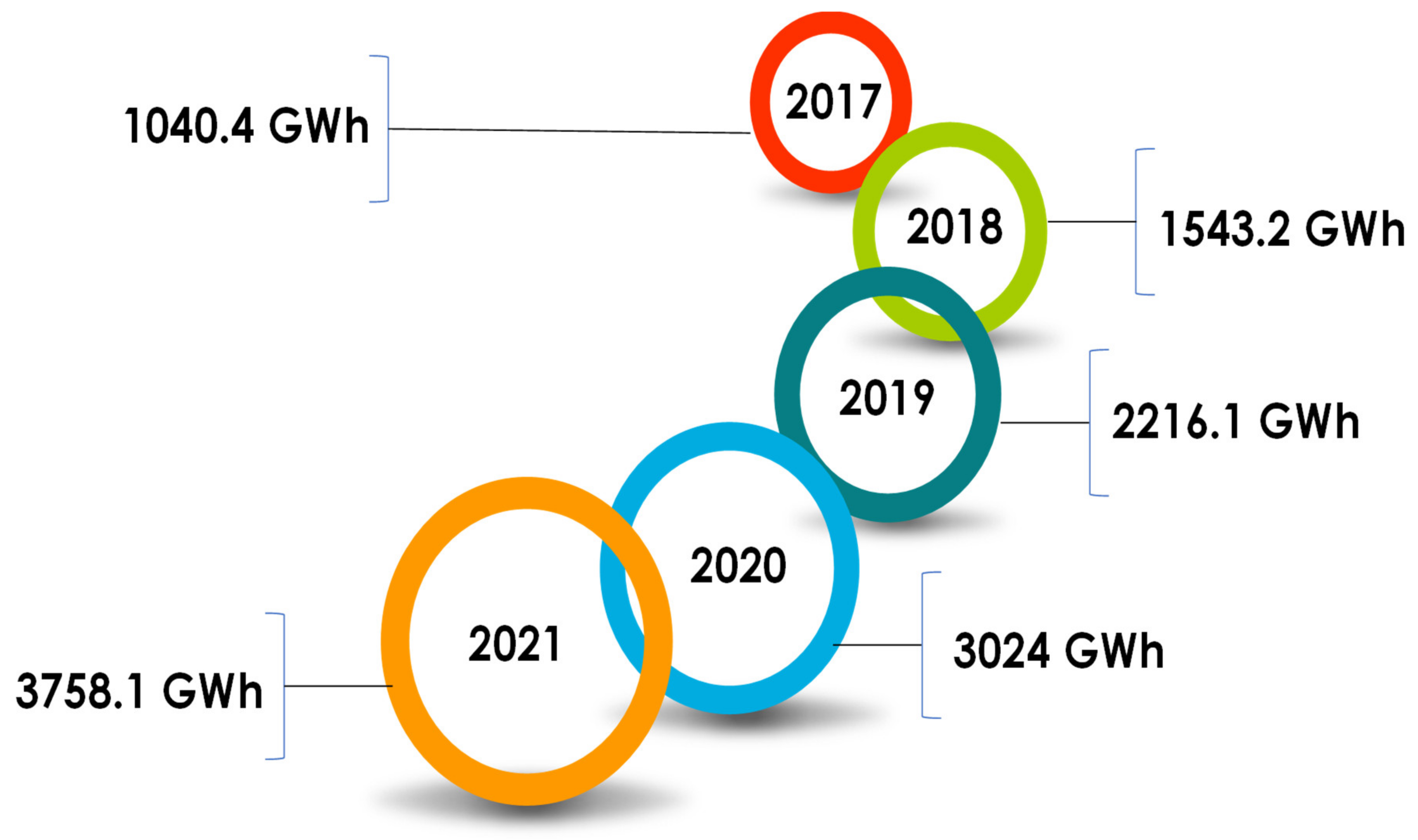

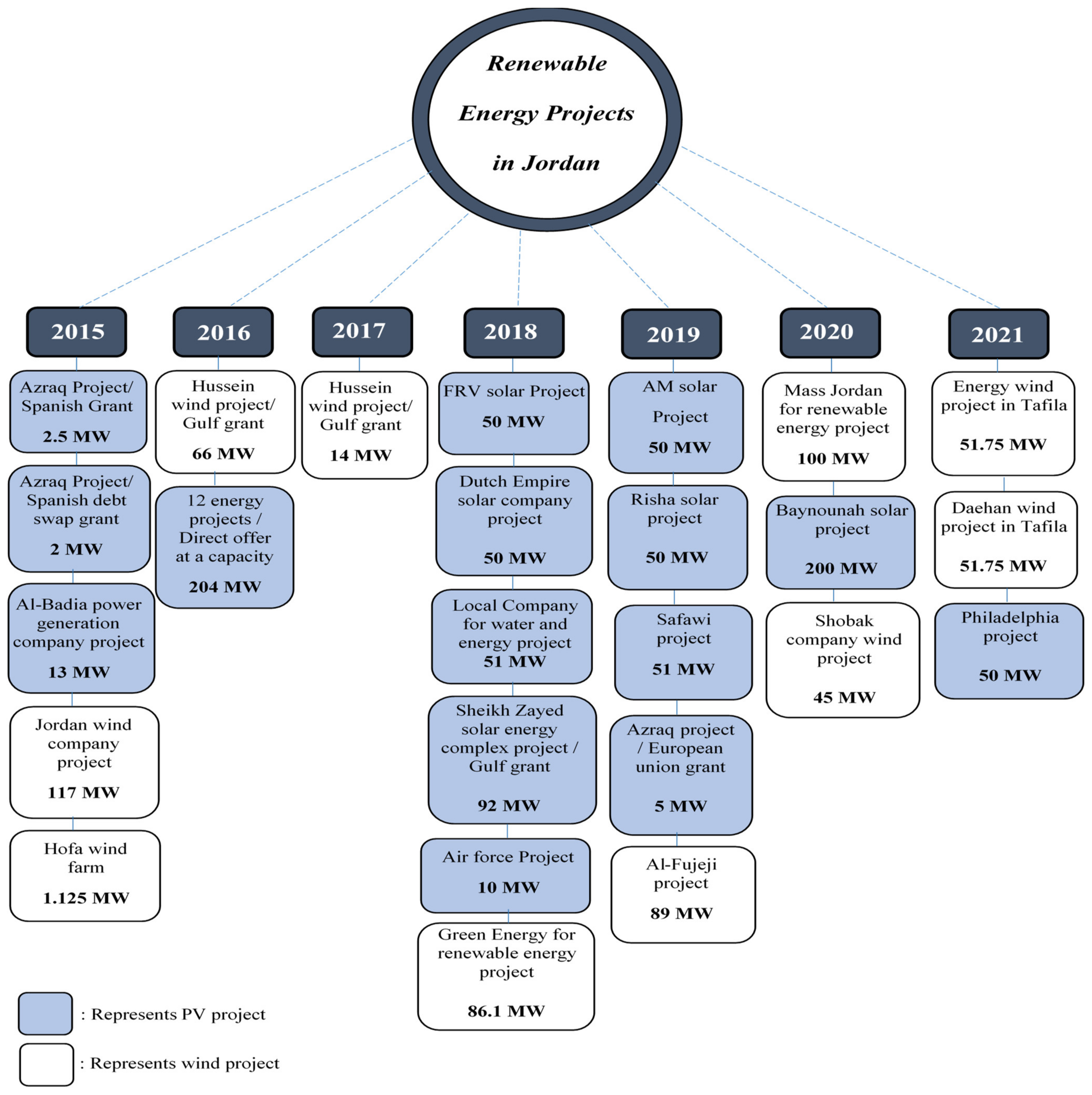
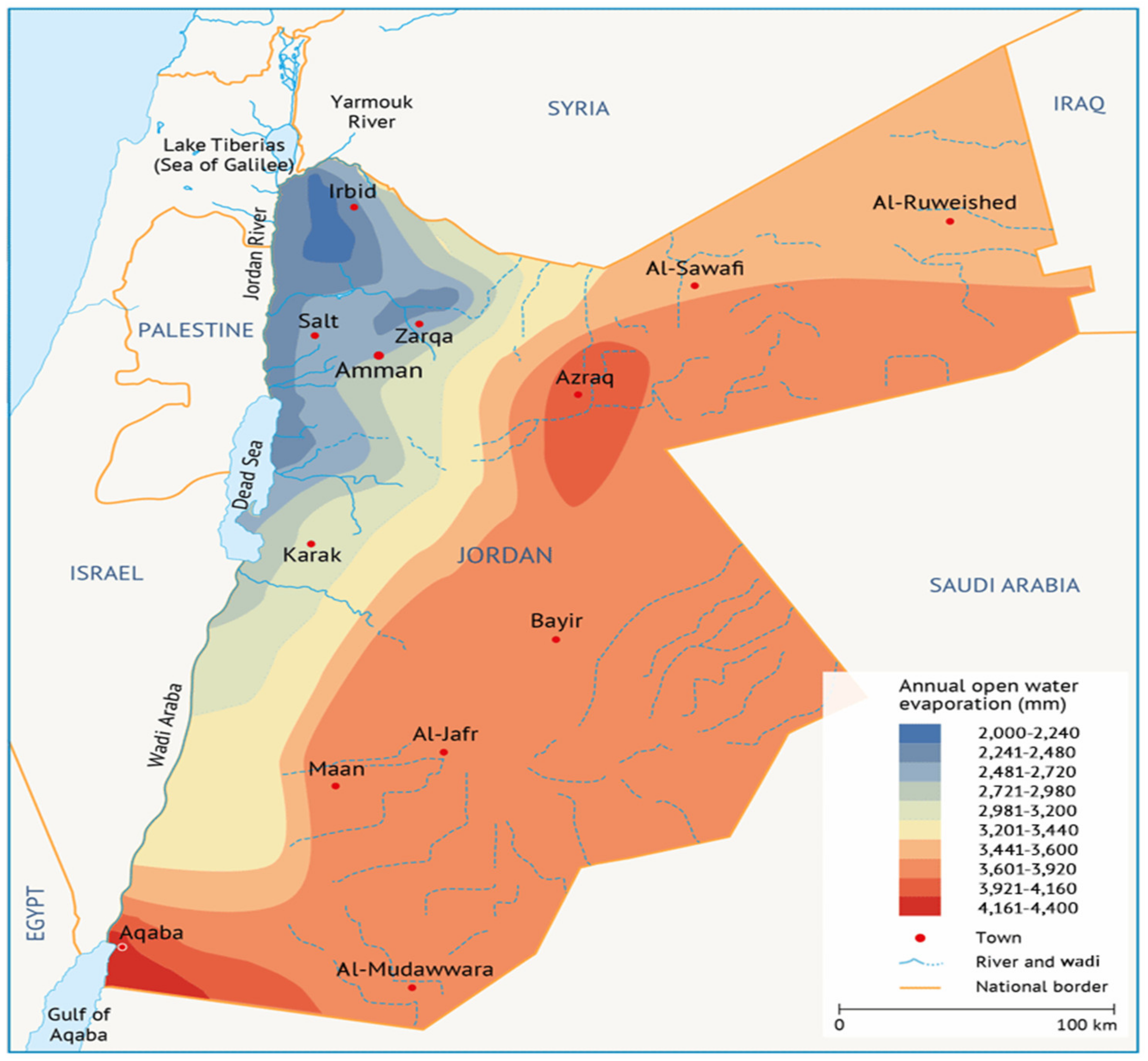
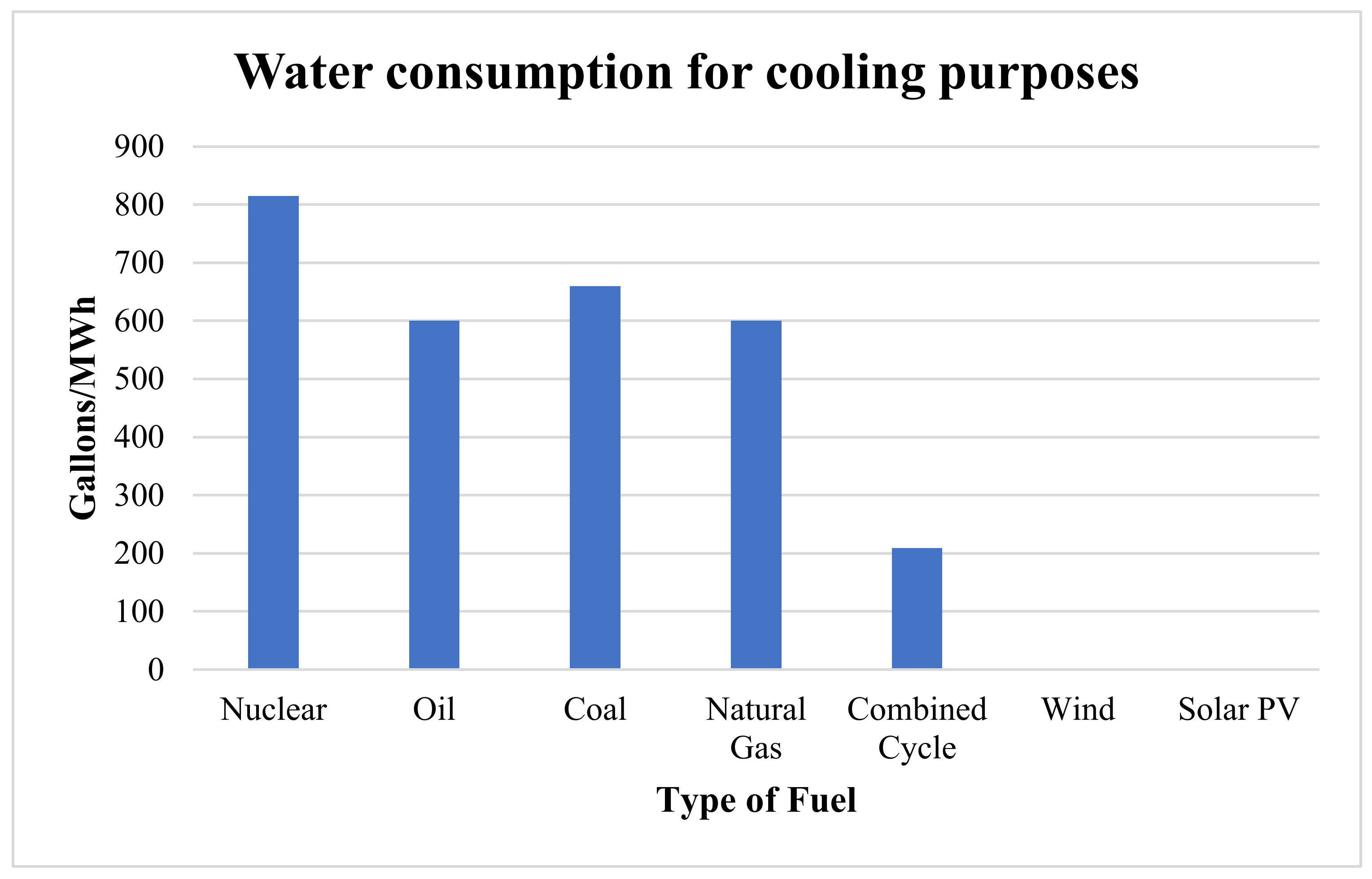



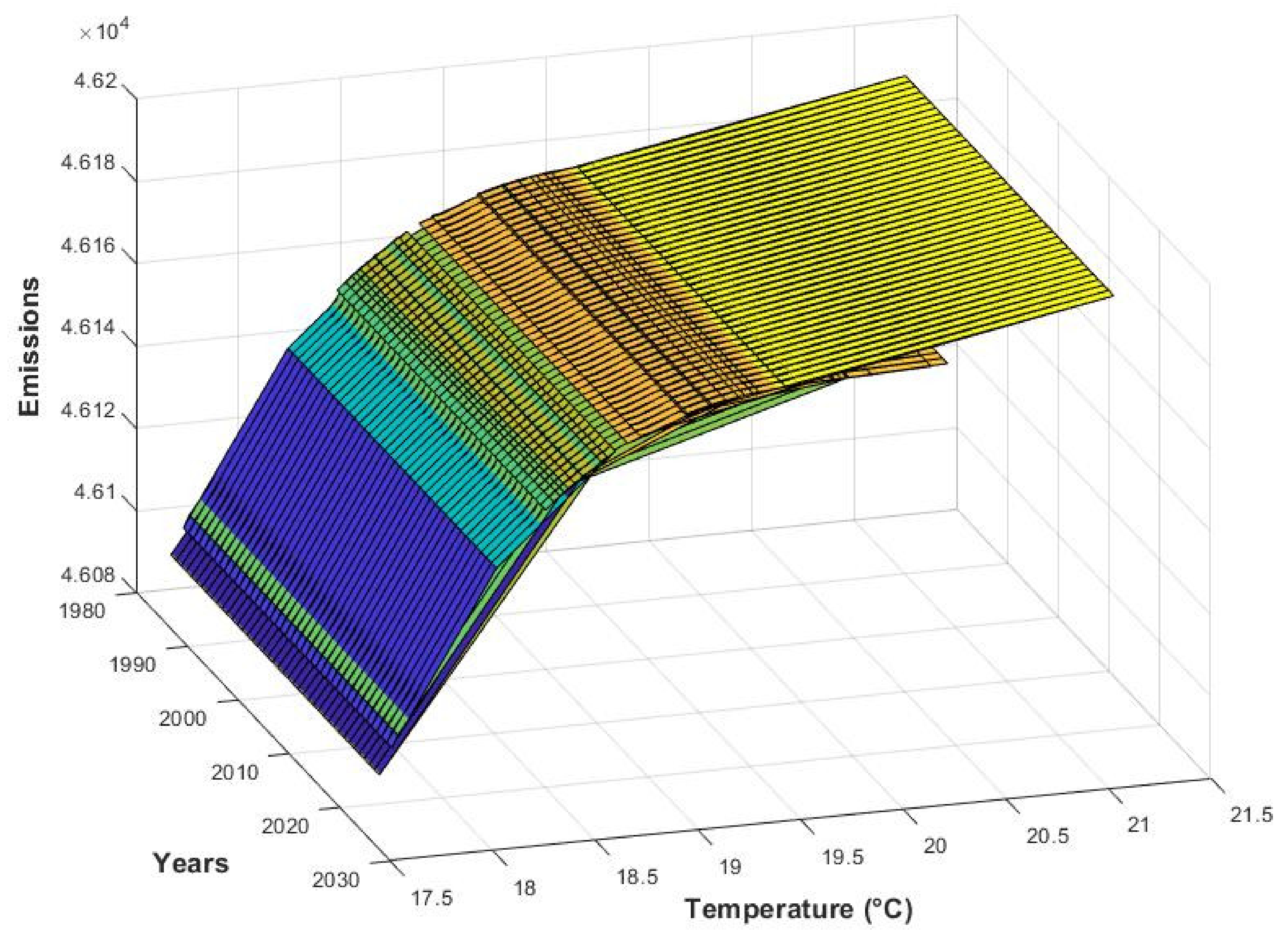
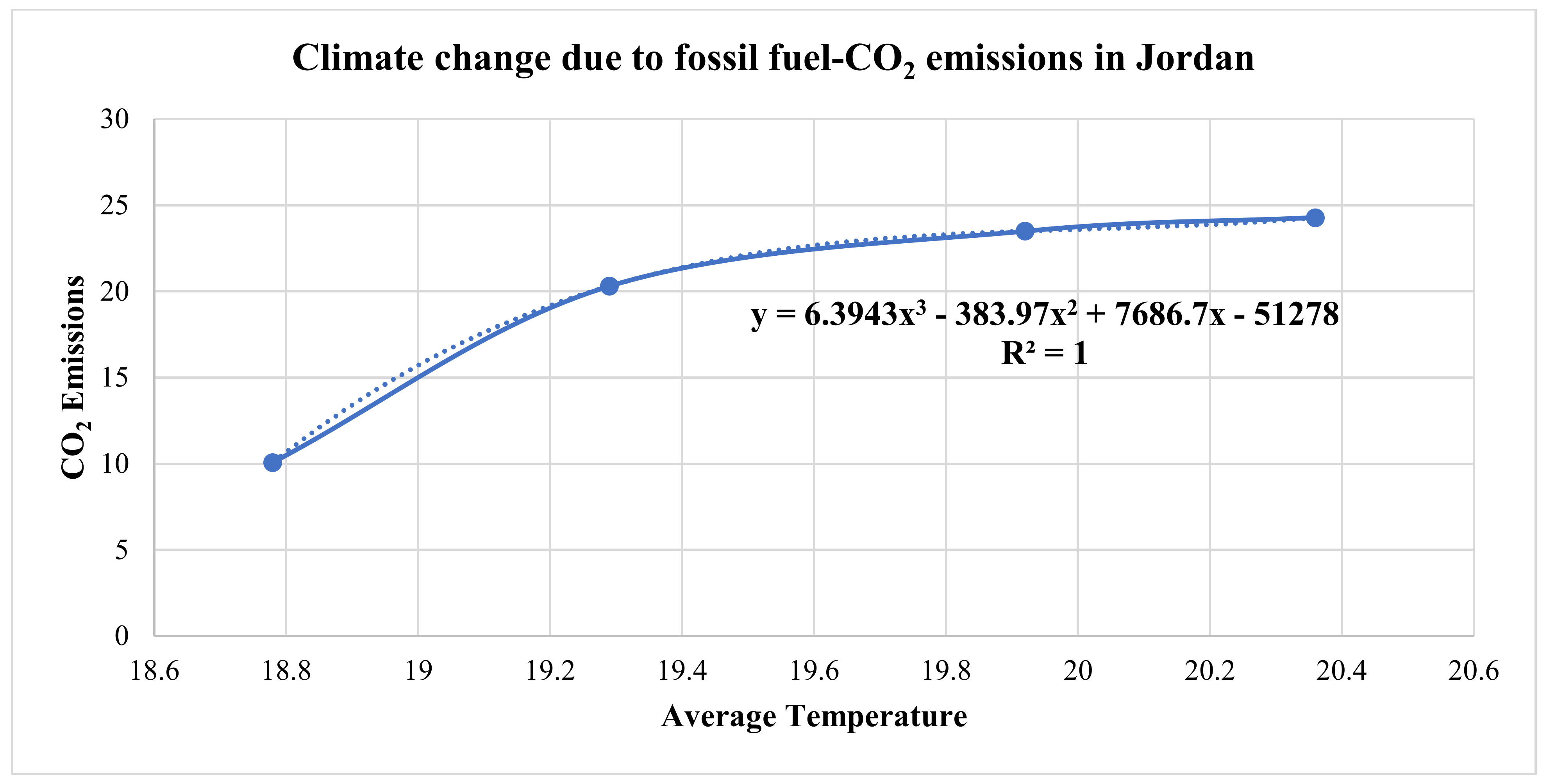
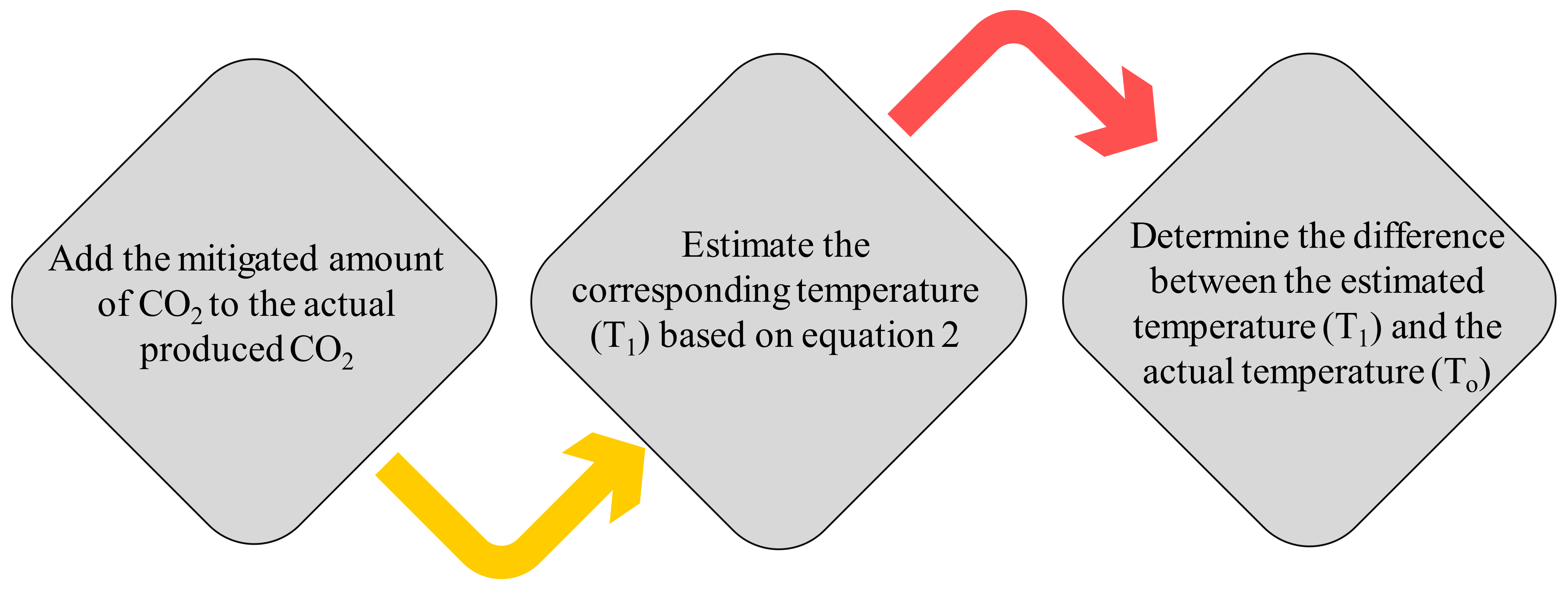
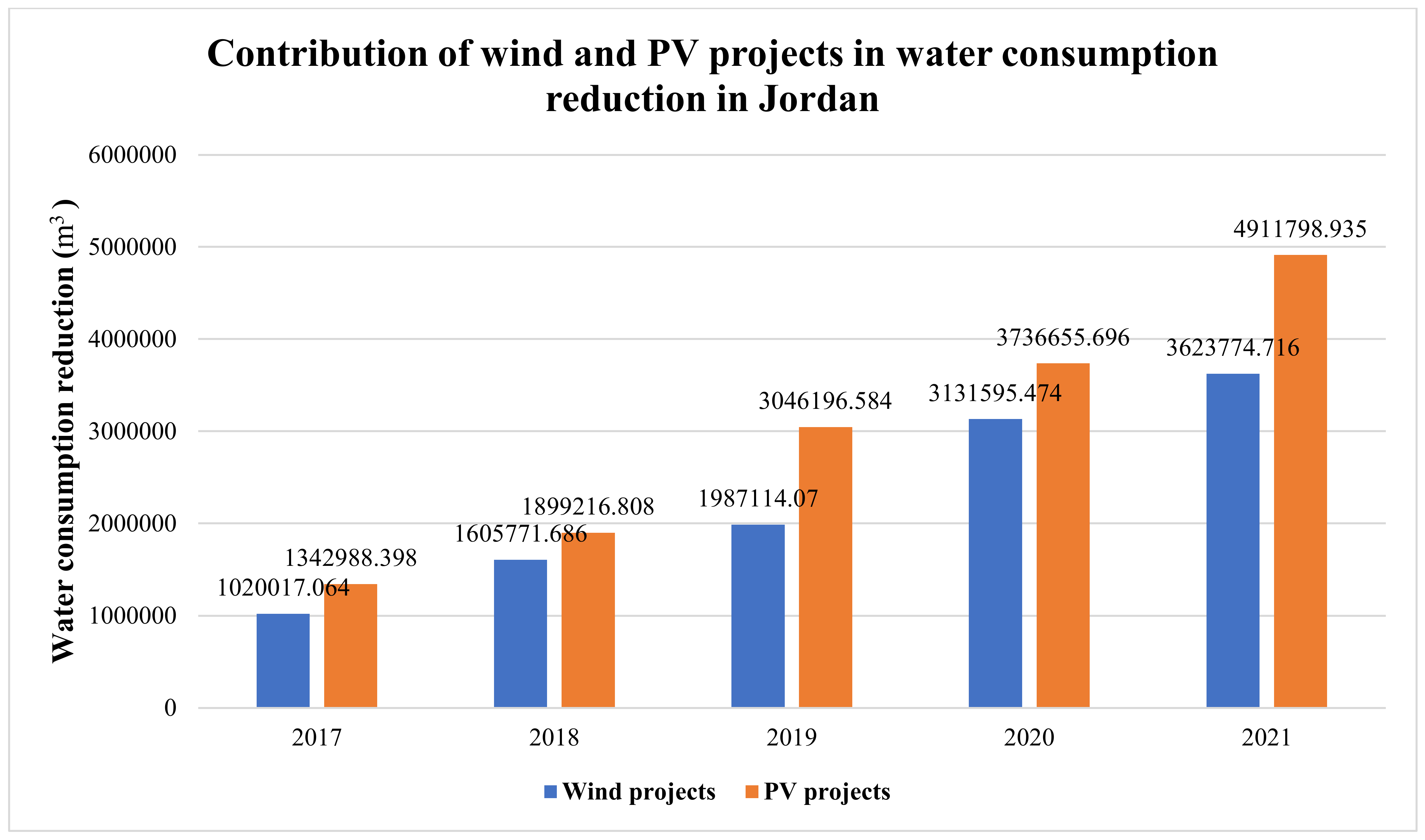
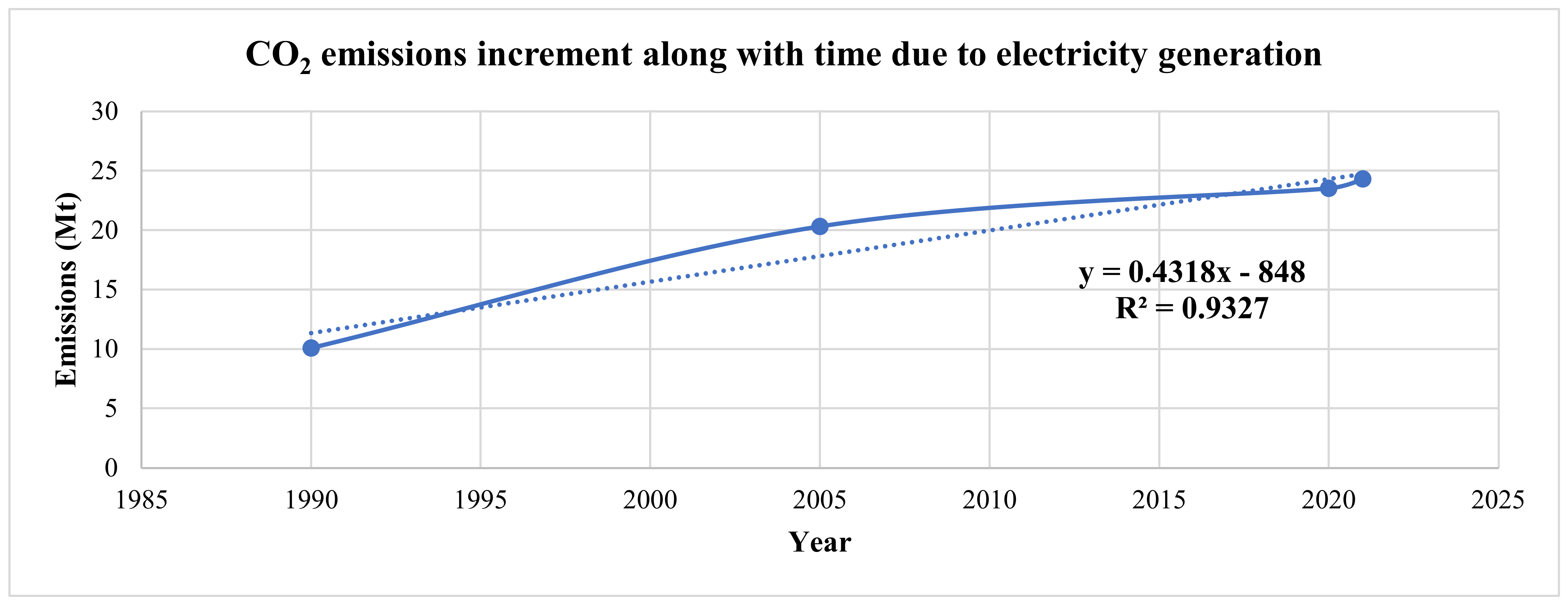
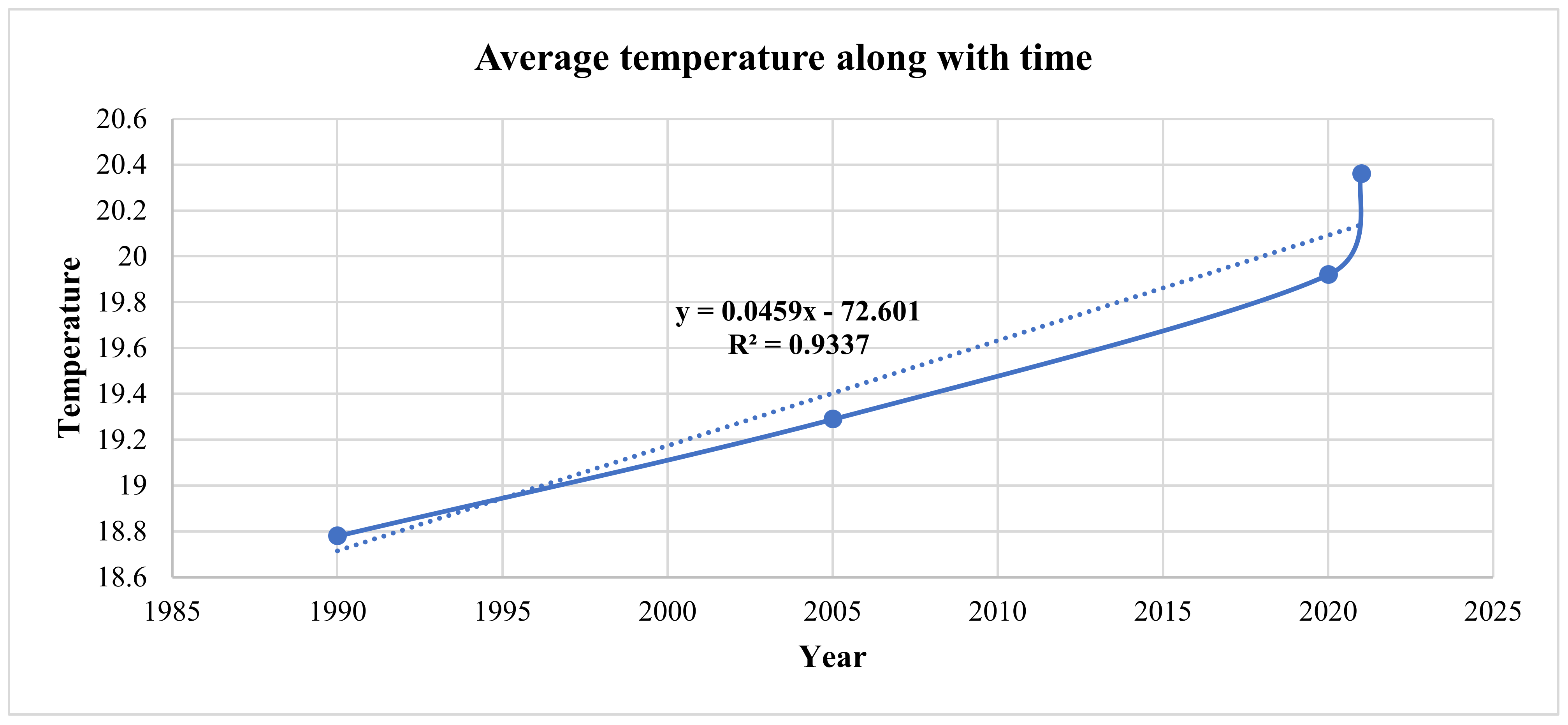
| Ref | Year | Country | Climate Change | Water Issues | Aim | Advantage | Disadvantage | Software/Tool | Used Standard/s | Duration of the Study |
|---|---|---|---|---|---|---|---|---|---|---|
| [16] | 2023 | Jordan | ✓ | ✓ | This study aimed to assess the possible effects resulting from climate change phenomenon, especially on the water surface ofAmman-Zarqa Basin, Jordan | The proposed model in this study provides the possibility for future estimation based on several scenarios presented in the paper. |
|
|
| 2018–2100 |
| [18] | 2022 | Germany, the UK, France, Italy, the USA, China and India | ✓ | ✘ | To investigate the behavior of the world, based on empirical analysis, if the goals of the EU that were set for emissions, energy consumption, and some other aspects were achieved | The presented scenario was based on the most polluting countries in the EU, which means that the proposed methodology is based on the worst case | NA | NA | 1990–2018 | |
| [21] | 2022 | Canada | ✓ | ✘ | Aimed to investigate the role of rural municipalities in planning for climate change risks | The first study that provides a comprehensive assessment of the rural climate change plans in Ontario and Canada more broadly |
| NA | NA | NA |
| [22] | 2022 | China | ✘ | ✓ | This study aimed to clarify that China has an interesting plan for water conservation in addition to enhancing the efficiency of water | Based on the implications and lessons of this study, developing countries may have insights to be able to manage water usage, especially in the agriculture sector |
| NA | NA | NA |
| [23] | 2023 | India | ✓ | ✓ | The aim of this study can be summarized by investigating and evaluating the future risks due to climate change | This study is helpful for drought managers, administrations and policymakers since it aids in developing the decision support for efficient drought management |
| NA |
| Historical data from 1980 to 2005 to make projections till 2099 |
| [25] | 2023 | Australia | ✓ | ✘ | This study aims to specify the extent that the environmental health officers (EHOs) are involved in climate change plans and health protection plans | This study shed light on some new aspects that are affected by climate change, such as the zoonoses |
| Qualtrics | NA | NA |
| [27] | 2023 | Egypt | ✘ | ✓ | The paper aimed to provide the helpful lessons that were learned from a pilot project to enhance the management of stormwater in a reasonable, cost-effective approach | It mentioned two real accidents that occurred due to the heavy rain in Cairo in 2018 and 2020, and based on them, their analysis was conducted |
| NA | NA | NA |
| [28] | 2023 | France | ✘ | ✓ | This study aimed to locate the water quality monitoring networks (WQMNs) effectively to enhance the economic value of information (EVOI) which are gathered by the WQMNs | It helped in defining a policy to reduce theagricultural nitrogen, therefore, reaching the desired nitrate at the WQMS |
| NA | NA | NA |
| [29] | 2022 | Japan | ✓ | ✘ | This study aimed to test the effects of the manufacturing process for some raw materials, such as copper, on CO2 emissions and climate change | The proposed methodology showed that the manufacturing process can be still introduced and minimize the CO2 emissions |
| NA | NA | NA |
| [30] | 2023 | Egypt | ✓ | ✘ | This paper aimed to examine the climate change impact in Egypt and how the Egyptian Government adopted this topic | Several resources were used to conduct this research, which made it dependability one |
| NA | NA | Based on the data collected in the period 1961–2000 |
| [31] | 2022 | Jordan | ✘ | ✓ | This study aimed to assess the energy and Carbon Footprints of the Amman Urban Water Cycle (UWC). | It clarified the contribution of the wastewater based on several scenarios. |
| Energy Performance and Carbon Emission Assessment and Monitoring Tool (ECAM 2.2) | NA | NA |
| [32] | 2020 | Jordan | ✘ | ✓ | This study investigates the current state of Jordan’s energy sector, highlighting its primary challenges and future aspirations. | It adds valuable insights to the ongoing discourse on how Jordan can attain environmental, economic, social, and political sustainability in its energy sector. | In the energy policy and strategies section, this paper concentrated on the history of Energy instead of focusing on the nowadays energy policies. Moreover, the absence of effective collaboration and mutual reliance among stakeholders in the energy sector and its associated sectors is evidence of inadequate governance and the untapped potential for harnessing the natural synergies between these industries. | NA | NA | NA |
| [33] | 2007 | Jordan | ✘ | ✓ | This study demonstrates the government’s adoption of a comprehensive approach to addressing water scarcity, encompassing both water resources planning and management and a strong emphasis on water demand management. | This paper explains the water supply types in Jordan deeply. | Most of the involved tables do not carry references. | NA | Public health standard. | The study forecasted the water resources development until 2020, starting from 2005 (2005, 2010, 2015, and 2020). |
| [34] | 2022 | Jordan | ✓ | ✓ | This study explores the current state of water security in Jordan and outlines the necessary policies and programs to achieve a more robust and resilient water security situation. | This paper links the water issues with climate change, the most essential topic in Jordan. | This paper investigated several points regarding water issues deeply, except water pollution in a deep manner. | NA | NA | NA |
| [35] | 2017 | Jordan | ✘ | ✓ | This paper analyzes the key strategies employed by the Jordanian government to regulate well expansion and water abstraction, as well as the corresponding reactions of farmers in the Azraq basin. Furthermore, it documents the recent proactive measures the Ministry of Water and Irrigation took to strengthen law enforcement and exert greater pressure on groundwater users, employing a range of innovative direct and indirect approaches. | This paper also discussed the agriculture sector and how it links with the water situation. | Concentrate on the law and policies without providing any recommendations regarding these laws and how they can be improved. | NA | NA | Based on the data of the world bank in the 1990s |
| [36] | 2019 | Jordan | ✘ | ✓ | This article addresses the existing research gap by examining the influence of the water scarcity discourse on three instances of transboundary water governance in Jordan: the Yarmouk River, the Jordan River, and the Disi Aquifer. | This study shed light on the reasons that lead to water scarcity | It focuses on the agreement between Jordan and the surrounding countries regarding water cooperation, although the title implies that it will discuss | NVIVO software | NA | NA |
| Alternatives | Quantity |
|---|---|
| Cars and Light trucks not used | 18.3 |
| Liters of gasoline not consumed | 42,967 |
| Barrels of crude oil not consumed | 233 |
| People reducing energy use by 20% | 100 |
| Acres of forest absorbing carbon | 22.7 |
| Hectares of forest absorbing carbon | 9.2 |
| Tons of waste recycled | 34.5 |
| Reduced tCO2 | Unused Cars and Light Trucks | Saved Gasoline (L) | Saved Barrels of Crude Oil | People Reducing Energy by 20% | Acres of Forest Absorbing Carbon | Hectares of Forest Absorbing Carbon | Tons of Waste Recycled | ||
|---|---|---|---|---|---|---|---|---|---|
| Wind ventures | Tafila 117 MW | 111,400 | 20,403 | 47,865,479 | 259,070 | 111,400 | 25,318 | 10246 | 38,414 |
| Maan66MW +Maan14 MW | 139,060 | 25,469 | 59,750,211 | 323,395 | 139,060 | 31,605 | 12,790 | 47,952 | |
| Fujeji | 126,809 | 23,225 | 54,486,298 | 294,905 | 126,809 | 28,820 | 11,663 | 43,727 | |
| Abour | 57,621 | 10,553 | 24,758,140 | 134,002 | 57,621 | 13,096 | 5300 | 19,869 | |
| Daehan | 57,621 | 10,553 | 24,758,140 | 134,002 | 57,621 | 13,096 | 5300 | 19,869 | |
| Tafila 100 MW | 102,185 | 18,715 | 43,906,050 | 237,640 | 102,185 | 23,224 | 9398 | 35,236 | |
| Shobak | 48,801 | 8938 | 20,968,431 | 113,491 | 48,801 | 11,091 | 4488 | 16,828 | |
| Rajif | 109,561 | 20,066 | 47,075,312 | 254,793 | 109,561 | 24,900 | 10,077 | 37,780 | |
| Hofa | 244 | 44.7 | 104,840 | 567 | 244 | 55.5 | 22.4 | 84.1 | |
| Solar PV ventures | Azraq 2.5 MW | 1844 | 338 | 792,315 | 4288 | 1844 | 419 | 170 | 636 |
| Azraq 2 MW | 1475 | 270 | 633,766 | 3430 | 1475 | 335 | 136 | 509 | |
| Albadia | 10,322 | 1890 | 4,435,076 | 24,005 | 10,322 | 2346 | 949 | 3559 | |
| 12 energy projects | 150,396 | 27,545 | 64,620,975 | 349,758 | 150,396 | 34,181 | 13,833 | 51,861 | |
| FRV project | 36,862 | 6751 | 15,838,575 | 85,726 | 36,862 | 8378 | 3390 | 12,711 | |
| Dutch project | 36,863 | 6751 | 15,839,005 | 85,728 | 36,863 | 8378 | 3390 | 12,711 | |
| Local Company | 37,599 | 6886 | 16,155,244 | 87,440 | 37,599 | 8545 | 3458 | 12,965 | |
| Sheikh Zayed project | 67,826 | 12,422 | 29,142,944 | 157,735 | 67,826 | 15,415 | 6238 | 23,388 | |
| AM Project | 29,489 | 5401 | 12,670,603 | 68,579 | 29,489 | 6702 | 2712 | 10,169 | |
| Air force project | 7373 | 1350 | 3,167,973 | 17,147 | 7373 | 1676 | 678 | 2542 | |
| Risha project | 36,869 | 6753 | 15,841,583 | 85,742 | 36,869 | 8379 | 3391 | 12,713 | |
| Safawi project | 37,602 | 6887 | 16,156,533 | 87,447 | 37,602 | 8546 | 3458 | 12,966 | |
| Philadelphia project | 43,190 | 7910 | 18,557,541 | 100,442 | 43,190 | 9816 | 3972 | 14,893 | |
| Baynounah solar project | 172,816 | 31,651 | 74,254,225 | 401,898 | 172,816 | 39,276 | 15,895 | 59,592 | |
| Azraq 5 MW Project | 3687 | 675 | 1,584,201 | 8574 | 3687 | 838 | 339 | 1271 | |
| Total yearly tCO2 reduction = 1427515 = 1.427515 Mt. | |||||||||
| Year | Average Temperature °C | CO2 Emissions (Mt) |
|---|---|---|
| 1990 | 18.78 | 10.087 |
| 2005 | 19.29 | 20.321 |
| 2020 | 19.92 | 23.510 |
| 2021 | 20.36 | 24.297 |
| Wind Ventures | PV Ventures | |||
|---|---|---|---|---|
| Year | Energy Output (MWh) | Water Consumption Reduction (Gallons) | Energy Output (MWh) | Water Consumption Reduction (Gallons) |
| 2017 | 449,100 | 269,460,000 | 591,300 | 354,780,000 |
| 2018 | 449,100 | 424,200,000 | 836,200 | 501,720,000 |
| 2019 | 874,900 | 524,940,000 | 1,341,200 | 804,720,000 |
| 2020 | 13,78,800 | 827,280,000 | 1,645,200 | 987,120,000 |
| 2021 | 15,95,500 | 957,300,000 | 2,162,600 | 1,297,560,000 |
| Cumulative water consumption reduction from 2017 to 2021 due to wind and solar projects = 6.9491 × 109 gallons | ||||
| Scenario 1 | Scenario 2 | ||
|---|---|---|---|
| Emissions tCO2 | Natural gas | Wind | PV |
| 5,424,915 | 112,838.232 | 553,341.33 | |
Disclaimer/Publisher’s Note: The statements, opinions and data contained in all publications are solely those of the individual author(s) and contributor(s) and not of MDPI and/or the editor(s). MDPI and/or the editor(s) disclaim responsibility for any injury to people or property resulting from any ideas, methods, instructions or products referred to in the content. |
© 2023 by the authors. Licensee MDPI, Basel, Switzerland. This article is an open access article distributed under the terms and conditions of the Creative Commons Attribution (CC BY) license (https://creativecommons.org/licenses/by/4.0/).
Share and Cite
Al-Quraan, A.; Darwish, H.; Malkawi, A.M.A. Renewable Energy Role in Climate Stabilization and Water Consumption Minimization in Jordan. Processes 2023, 11, 2369. https://doi.org/10.3390/pr11082369
Al-Quraan A, Darwish H, Malkawi AMA. Renewable Energy Role in Climate Stabilization and Water Consumption Minimization in Jordan. Processes. 2023; 11(8):2369. https://doi.org/10.3390/pr11082369
Chicago/Turabian StyleAl-Quraan, Ayman, Hiba Darwish, and Ahmad M. A. Malkawi. 2023. "Renewable Energy Role in Climate Stabilization and Water Consumption Minimization in Jordan" Processes 11, no. 8: 2369. https://doi.org/10.3390/pr11082369
APA StyleAl-Quraan, A., Darwish, H., & Malkawi, A. M. A. (2023). Renewable Energy Role in Climate Stabilization and Water Consumption Minimization in Jordan. Processes, 11(8), 2369. https://doi.org/10.3390/pr11082369









